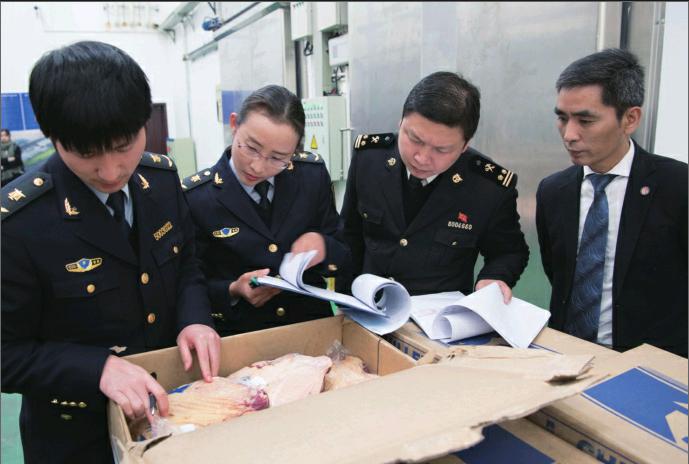A TASTE FOR THE BEST
2017-09-07ByDengYaqing
By+Deng+Yaqing



Chinas enthusiasm for fine dining is as strong as the Great Wall itself and older. About 7,000 years ago, the Chinese developed sophisticated culinary skills and several styles of exquisite dishes, which continue to fascinate foodies around the globe. Since then, more spice has been added to Chinese food habits. The Chinese dining table is becoming increasingly diversified with imported food tickling Chinese taste buds—a tribute to the growing spending power of Chinese consumers and their role in making global trade and the world economy grow.
A new chapter was added to Chinese food history on June 20, when the General Administration of Quality Supervision, Inspection and Quarantine announced that American beef would be re-allowed after being shut out of the Chinese market due to mad cow disease in 2003. The decision was one of the fruits of the China-U.S. 100-Day Action Plan formulated after President Xi Jinpings meetings with his U.S. counterpart Donald Trump in Mara-Lago, Florida, in April.
Three days later, the first batch of American beef passed the inspection of the Beijing EntryExit Inspection and Quarantine Bureau.
According to statistics from the Ministry of Commerce, in 2016, the Chinese consumed 8 million tons of beef, creating a market sized at 360 billion yuan ($53.94 billion), a vast business of which overseas players are scrambling for a share.
In recent years, China has witnessed a dramatic rise in beef imports from South America, primarily because Chinese consumers now have a higher demand for quality products, Xie Wenze, a research fellow with the Institute of Latin American Studies at the Chinese Academy of Social Sciences, told the International Business Daily.
Indeed, for countries such as Argentina and Brazil, beef export has been a new growth point for their economies. Xie said compared with other countries, Argentinian beef is superior in taste. The recognition from Chinese consumers is also partly due to China-Argentina bilateral relations having become closer in the past few years. However, Argentina has formidable rivals, such as Australia and New Zealand, which still remain the main sources of Chinas imported beef by dint of their free trade agreements with China.
Fruit of affluence
The import of agricultural products such as grape wine and rice has also experienced rapid growth in China. According to a report jointly released by Vinexpo and International Wine and Spirit Research (IWSR), in the first half of this year, Chinas grape wine imports increased by 13.9 percent year on year, with Chilean wine registering the fastest growth. In May alone, Chile exported grape wine worth $24 million to China, a year-on-year increase of 49 percent, buying 50 percent more than the United States, its second largest wine export destination.
Though Chilean wine is a late entrant in the Chinese market, it is still expanding its market share by leaps and bounds. This is partly thanks to the China-Chile Free Trade Agreement signed in 2005, which allows grape wine imports zero tariff treatment from 2015. In 2016, China imported $195-million worth of grape wine from Chile, replacing the United States as the largest export market for Chilean wine.
The Vinexpo-IWSR report says China is likely to become the second largest grape wine market by 2020, when its total consumption will reach 94 million boxes.
“The grape wine competition is global. As more and more Chinese become grape wine connoisseurs, 70 percent of the countrys market demand will be met by imported wine in the future,” Zhou Hongjiang, General Manager of Yantai Changyu Pioneer Wine, told Peoples Daily.
Last year, China imported 206.93 million tons of grain, according to statistics from the Ministry of Commerce. “Despite the high[domestic] output, China imports rice from other countries every year. In fact, since 2013, China has been the largest rice importer in the world,” Mu Yueying, a professor from the College of Economics and Management, China Agricultural University (CAU), said.
Japanese rice, an expensive variety, is already in use in some regions in China and American rice is expected to make its debut soon.
“As the middle class keeps expanding in China, demand for rice has gradually shifted from quantity to quality,” said Zhai Liushuan, another professor from CAUs College of Economics and Management.
Aside from rice, soybean imports are also on the rise. The United States is a major source country because its high yields and efficiency in growing soybeans can better offset the underproduction of soybean in China, Mu said.
Beefing up global trade
With imports rising, there are some concerns that domestic production may be negatively impacted. However, experts point out that with the huge demand in China, imports will complement domestic production. Beef serves as a good example.
Cui Kai, a commentator holds a Ph.D. in food engineering, told Economic Daily that the large quantities of beef imports, priced lower than the domestic offerings, would not necessarily hit Chinas livestock industry. Import trade can alleviate the pressure on domestic supply, spur the sector to undergo restructuring, and raise quality and production efficiency, Cui said.
Currently, beef imports account for a mere 10 percent of total domestic consumption. So the entry of American beef is not likely to have a negative impact on the Chinese market, Cui said, explaining that the imports can push the domestic industrial chain to upgrade and achieve technological progress.
For years, Chinas beef industry has been relatively backward, being small-scaled with a scattered distribution and high processing and transportation costs. Competition from overseas can stimulate the establishment and completion of the domestic beef industrial chain and promote brand building, Cui pointed out.
China contributed 33.2 percent to global growth in 2016, the highest among all countries in the world, while the massive increase and upgrading of Chinese consumption has played a key role in lifting global trade and economic growth.
During the 13th Five-year Plan (2016-20) period, the annual per-capita disposable income in China is expected to increase by 30 percent and goods and services imports are projected to increase to $9 trillion and $2 trillion, respectively. In 2015, the population of Chinese with relatively high income, a per-capita disposable income of $10,000 or more, surpassed 150 million, accounting for 20 percent of the total urban population. Their combined purchasing power cant be ignored by any foreign brands.
“China has witnessed rapid increase in its imports, and the ongoing consumption upgrading boasts immense potential, thus making a great contribution to global economic recovery,” Zhao Jinping, a senior researcher with the Development Research Center of the State Council, said.
